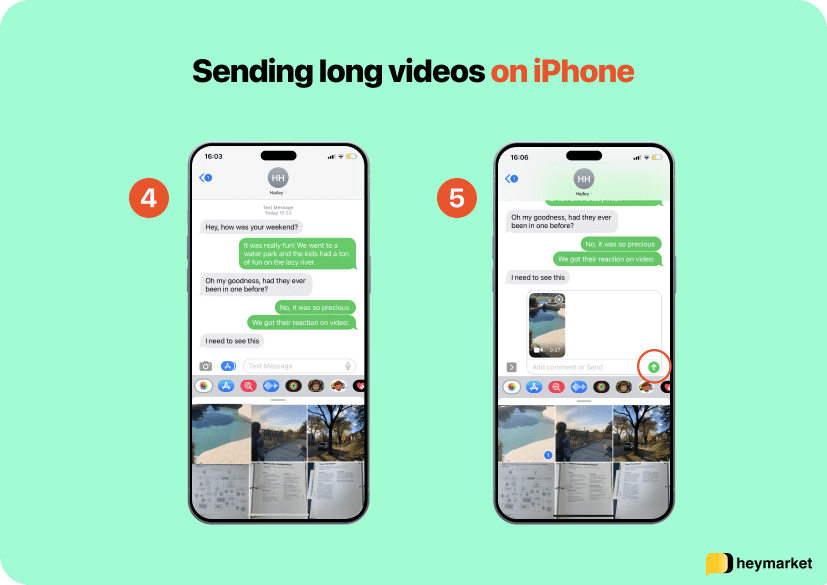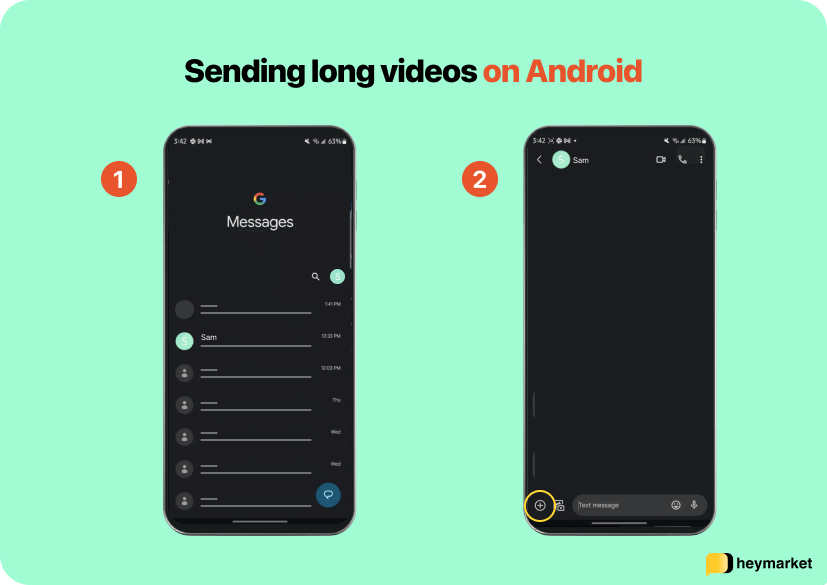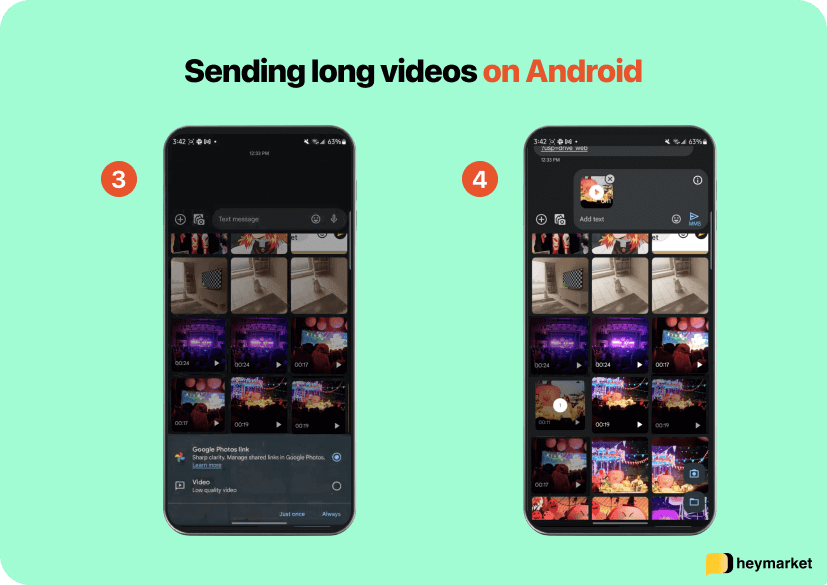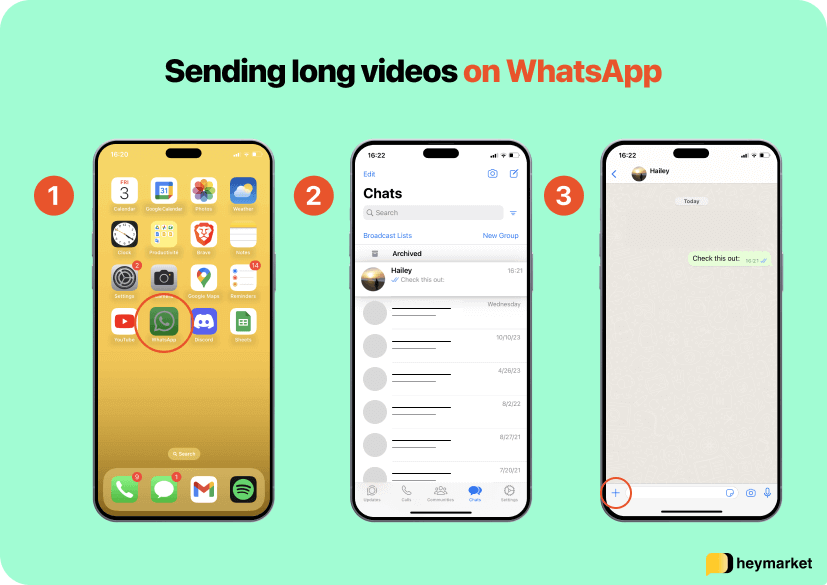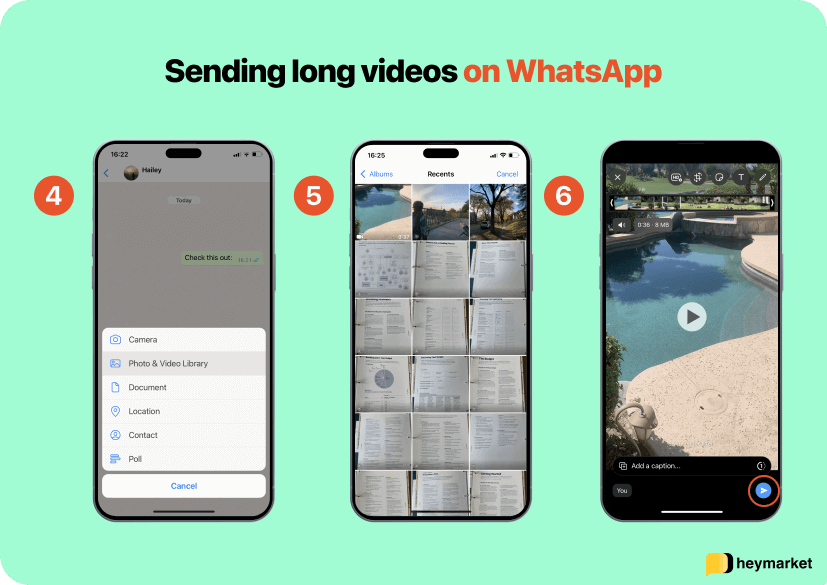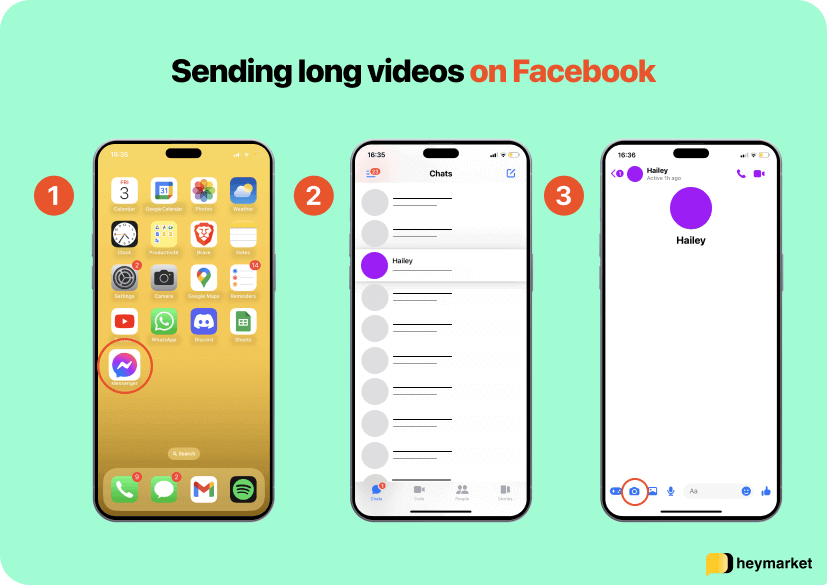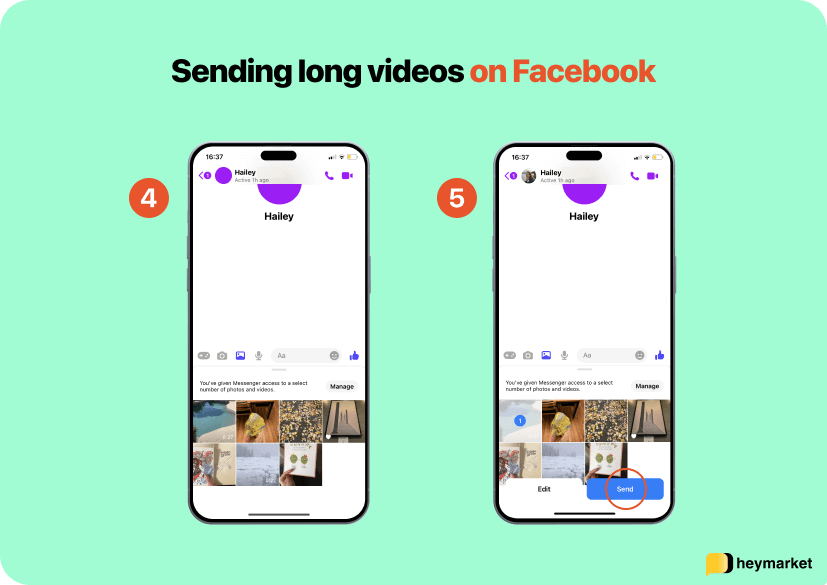Sharing videos is a great way to connect with friends, family, and business contacts. Whether you send videos of your new puppy to friends, a recording of your graduation to a family member, or a new product demo to potential customers, video lets you form better connections with your recipients. These longer-form videos can capture entire scenes that pictures can’t do justice to, but they come with their own hurdles to overcome.
Texting videos is a bit more complicated than texts or pictures. As videos get longer or the resolution increases, so does the file size. The larger the file, the more likely you are to run into that dreaded “not delivered” message or end up with a grainy, low-resolution video that’s hard to see. Not being able to text long videos is frustrating for individuals and inconvenient for businesses, so finding a way to share your media effectively in its entirety is essential.
If you don’t know how to send a long video through text, your media may have a hard time getting to your contacts. But instead of chopping the video up and sending it in small pieces, let us show you how you can overcome the limitations and make use of the available alternatives to share your videos how you want.

Learn how Heymarket can help your business build strong connections with texting.
Book a demoUnderstanding the limitations of sending long videos through text
When you send a text, you’re sending either a Short Message Service (SMS) or a Multimedia Messaging Service (MMS) text. MMS and SMS are similar because they both use your cellular network to communicate with other phones, but the content they can send is different.
SMS is for sending text-based messages. MMS enables you to text pictures, gifs, videos, and files in addition to sending text messages. However, like character limits on SMS, MMS also comes with its own limitations.
How long of a video can I send through MMS?
Your cellular carrier is the one that determines how long of a video you can send. Carriers impose these limits to avoid overloading their systems and slowing down the service for each user. These limitations depend on the size of your video file, which is determined by its resolution, frame rate, and length. (For a closer look at how to calculate your video’s file size, we included more granular information at the end of this article.)
To further complicate things, each carrier has its own limits: Verizon caps images at 1.2 MB and videos at 3.5 MB, T-Mobile imposes a 1 MB limit for sending MMS and a 3 MB limit for receiving them, and AT&T has a flat 1 MB limit for all multimedia. So, you could send the largest video file from Verizon to T-Mobile or AT&T, but they couldn’t receive it – and it would only be about 3.5 seconds of video at the lowest resolution.
As a result, compression happens to most modern videos sent via MMS to achieve a smaller file size for easier transmission. However, a smaller file can only hold so much data, which leads to a lowered resolution, slowed framerate, and overall blurrier and more pixelated visual experience that is harder to interpret.
How to send long videos through text for individuals
There are a few different options for sending long videos as part of personal text messages, including native solutions for iPhones and Androids as well as third-party apps.
Before continuing, be sure you have MMS enabled and cellular data turned on for your iPhone or Android device.
Sending videos through text using an iPhone
You can send a long video using an iPhone by doing the following:
- Select the Messages app.
- Choose an existing conversation by tapping on it, or create a new text by pressing the pen and paper in the top right.
- Once you have a contact to text, press the multi-colored button that’s located below the camera icon and above the ‘Q’ key on the left side of the keyboard to access your photos.
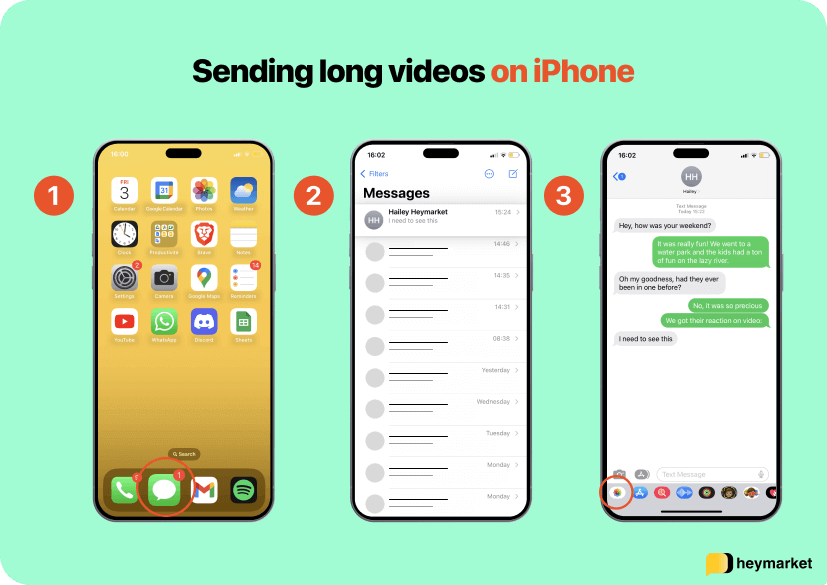
- Scroll through your camera roll and tap on the video you want to send. This adds it to your text box.
- Tap the up-facing arrow to the right of the text box to send the text.

If you are sending a text to another iPhone user through iMessage, the send button will be blue and you’ll be able to send files up to about 100 MB by using Wi-Fi instead of cellular data. There may still be some compression, but the increased limit means you can avoid poor quality due to excessive compression.
If you’re texting Android or other devices, you’re limited by your carrier’s limit and the recipient’s carrier limit. However, to lower your file size and minimize the compression required, you can change the resolution of your camera by going to settings and selecting ‘camera’ to access the different options available.
Sending videos through text using an Android
Android devices have two different native texting apps, Google Messages and Samsung Messages, that you can use to send MMS.
Here’s how to send a video through Samsung Messages:
- Select the Samsung Messages app.
- Select a conversation or tap the bottom-right icon that looks like a bubble to create a new conversation.
- Tap the far-left picture icon or the ‘+’ icon and select “video” to access your gallery.
- Select the video to attach to your message by tapping it.
- Tap the send button on the far right side of the text box to send the message.
Samsung Messages has a file limit that is equal to your carrier. Fortunately, Google Messages is more versatile and offers a feature that makes sending long videos to other Android devices more feasible.
Google Messages offers a feature known as Rich Communications Settings (RCS), also known as Advanced Messaging. It aims to be a direct upgrade to SMS and MMS by offering file size limits up to 100 MB, rivaling iMessage and allowing for higher-quality and longer videos to be sent.
RCS uses Wi-Fi or cellular data to facilitate communication through the internet rather than your carrier’s cellular network, which allows it to bypass carrier limits. However, like iMessage, you can only use RCS to text others with the feature enabled.
You can enable RCS on eligible phones and networks by:
- Going to your Google Messages app
- Tapping the three vertical dots on the right side of the screen
- Choosing settings from the menu
- Going to “chat features”
- Tapping the toggle next to “Rich Communication Settings”
Once you’ve enabled Advanced Messaging, do the following to text a long video:
- Go to your Google Messages app.
- Choose an existing conversation or start a new one.

- Tap the ‘+’ icon and choose “video,” or tap the camera and gallery icon to access your gallery.
- Select a video from your gallery and tap it to add it to the message.

Sending videos through WhatsApp
WhatsApp is one of the most popular third-party messaging apps in the world – and it offers one of the highest file size limits at 2 GB to help minimize quality loss from compression.
You can do the following to send a long video through WhatsApp:
- Open your WhatsApp app.
- Select an existing conversation or start a new one by tapping the icon in the top right of the screen.
- Press the ‘+’ icon to the left of the text box in the bottom left of the screen.

- Select “photo & video library” from the menu.
- Choose your video and tap it.
- Press the blue send icon in the bottom right.

WhatsApp is an internet-based messaging app, so it doesn’t have carrier limitations but requires cellular data or Wi-Fi connectivity. It’s also supported on most phone types, allowing you to reach a wider range of contacts with a single app.
Sending videos through Messenger
Messenger by Meta is a popular third-party messaging app with a file size limit of 25 MB that you can use on both Androids and iPhones.
You can send long videos through Messenger with the following:
- Open the Messenger app.
- Choose an existing conversation or begin a new one by tapping the pen and paper icon in the top right.
- Tap the photo icon, located between the microphone and camera, to access your gallery.

- Select your video.
- Tap “send” in the bottom right to send the video.

Messenger is another web-based messaging app that requires data or Wi-Fi to use.
How to send long videos through business texting
Business text messaging is a highly effective element of communication for businesses. You can text customers marketing content, alerts, reminders, confirmations, and even provide customer service once you’ve captured their opt-in.
As a business, sending videos can be a great way to engage potential leads and nurture relationships. You might send a product demo, a testimonial, or an instructional video to your contacts to get their attention and build up hype for your business.
Your business texting platform should enable you to send MMS directly from its messaging interface to individuals and to lists as part of a mass text messaging campaign. While the size of these texts is still limited by the recipient’s carrier limitations, the ability to create MMS-friendly videos and other content to use as part of customer service and marketing can help improve engagement and customer satisfaction.
If you want to send individual long videos through a business texting platform, here’s what to do:
- Access your business texting app.
- Navigate to your chats.
- Start a new conversation or access an existing one.
- Locate your attachment button and press it.
- Select your video and return to the texting screen.
- Send the MMS to your contact.
You can also send mass texts with videos:
- Access your business texting platform.
- Navigate to Lists, then create or select the list of contacts you want to send the video to. Note: You can only send text messages, including videos, to contacts who have opted in to receive text messages from you.
- Create a new text and click the attachment button to add a video.
- Schedule the text or send it immediately.
You can also include videos in your text messaging drip campaigns by navigating to Campaigns, selecting a list, then composing your series of text messages. You can add videos by clicking the attachment button.
The specific steps for sending long videos through MMS will depend on your business platform, but most apps will include the ability to add videos.
Alternative methods for sending videos via text
It’s no secret that using MMS to send a long video through text isn’t the most efficient way to share your content. Fortunately, there are a variety of other ways you can share a video with someone.
Email has been one of the most popular ways to share videos for decades. You can easily attach files to your email, keep a record of the conversation, and share the videos with just a few clicks or taps.
However, like MMS, email’s file size limits are established by the service itself. Gmail, Outlook, and other email servers limit file sizes to between 20-25 MB, which makes it hard to attach longer videos to your emails.
Fortunately, email works well alongside cloud storage to make it possible to share large files quickly.
Pros:
- Easy to attach videos
- Can view conversation history
- Connects to email for retrieving files from cloud storage
- Business-friendly
Cons:
- 25 MB file size limit
Cloud storage
Cloud storage has revolutionized data storage and management in the modern world. With cloud storage, you don’t need personal hardware to be able to move and store large amounts of data – you can simply use existing servers from tech titans like Google.
Google Drive is a perfect candidate for hosting long videos that you want to share with others. Its file size limit is a staggering 750 MB, meaning you can upload most personal videos without a problem. Once you do, you’ll receive a direct link to the file where others can download it off of Google Drive.
However, sharing a Google Drive link through text doesn’t exactly make it easy for your friends or family to access the video from devices other than a computer. People who aren’t tech-savvy may also struggle with the complexity of the process.
Pros:
- 750 MB file size limit
- Direct links to uploaded files
- Business-friendly
Cons:
- Not very mobile-friendly
- Can be hard to access for some users
Google Photos
Google Photos is a photo-sharing site that makes it easy to upload, view, and download images. It’s similar to Google Drive but is more visual, allowing users to create albums while providing a more user-friendly interface.
The file size limit is 10 GB for videos, so you’ll be able to upload very long videos without having to worry about compression and quality degradation.
A significant consideration is that the storage you use from Gmail, Google Drive, and Google Photos is shared. If you exceed your limit with photos, you might not be able to receive and store new emails or other crucial data.
Pros:
- 10 GB video file size limit
- Visual interface
- Direct links to content
Cons:
- Storage syncs with other Google services
- Not business-friendly
Social media
Social media platforms like Twitter, Facebook, and Instagram are candidates for sharing videos through either direct messages (DMs) or private posts. They’re easily accessible to anyone with an account, and they can share them easily as well.
Each platform has different file size limits for their platform, including 60 seconds of video for Instagram DMs, 256 MB for Twitter DMs, and 25 MB for Facebook Messenger DMs.
Pros:
- Shareable content
- Direct links to content
- Larger file size limits in most cases
Cons:
- Requires social media accounts
YouTube
YouTube has been the most popular video platform for decades, so it makes sense to consider sharing your videos on it.
YouTube videos have their own direct links, which makes them easy to access. You can also make them private to ensure only people you want to see them have access to. YouTube’s file size limit is 128 GB, allowing you to upload most personal videos without significant compression. Viewers can even change the quality themselves for the best viewing experience.
Pros:
- Direct links to content
- 128 GB file size limit
- Keeps your videos organized
- Allows for customizable video quality playback
Cons
- Requires an account
- Upload times may be slower
The benefits of video compression for sending long videos
Compression is the process of shrinking a file size so that it’s easier to send and receive. The limits that carriers impose make it hard to use modern smartphone cameras when sending videos because they take high-resolution photos and video. A higher resolution creates clearer videos due to an increase in the number of pixels used to render the image, but more pixels also means a larger file size.
When done correctly, compression strikes a balance between smaller files and high-quality video. It’s not very effective for traditional MMS that have low file size limits due to the amount of compression that cellular carriers require, but for applications with a higher limit, reasonable compression allows individuals and businesses to share a wide range of longer videos without sacrificing as much quality.
The best way to take control of your video quality is to perform compression yourself. This way, you can monitor the file size and quality of the video to ensure it meets both requirements.
How to calculate your video’s file size
If you want a more granular way to determine your video’s file size, we got in the weeds to give you some guidelines.
Generally, videos taken with modern Android and iPhone cameras will range between 1 megabyte per second to 5 megabytes per second.
Higher-resolution, higher-frame rate, and longer videos create a larger file that becomes harder to send and receive. For example, we took a 10-second video with an iPhone SE in 720p, 1080p, and 4K at 30 and 60 frames per second to help estimate how large of a file your video would be.
Here are our results for a 10-second video:
| Video resolution | 30 frames per second | 60 frames per second |
| 720 pixels | 10 MB (1 MB/sec) | N/A |
| 1080 pixels | 18.2 MB (1.8 MB/sec) | 27.6 MB (2.7 MB/sec) |
| 4K | 52.3 MB (5.2 MB/sec) | 116 MB (11.6 MB/sec) |
As you can see, when the resolution or frame rate increases, the file size increases as well. With this information, you’re able to calculate how large your video file will be and compare it against your carrier limit to see if you can send MMS over your cellular network.
Discover the right way to send a long video through text
No matter what kind of device you have, what network you’re on, and if you’re sending videos for personal use or business, there are options for sharing large files. Your carrier imposes low limits on MMS, which makes it hard to send modern-quality videos over your cellular service. But with the help of internet-connected messaging solutions, you can send a long video through text to just about anyone.
Need a business texting solution that helps you send mass video texts to your contacts? Heymarket’s all-in-one platform enables MMS at scale and integrates video sharing into sales, customer service, and marketing.





